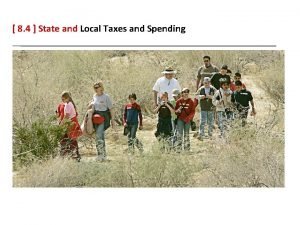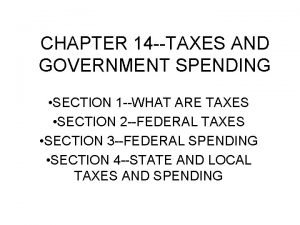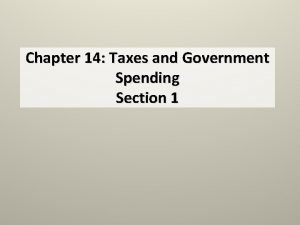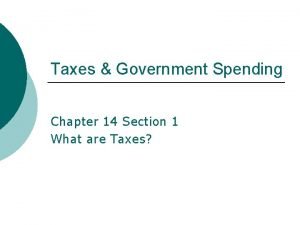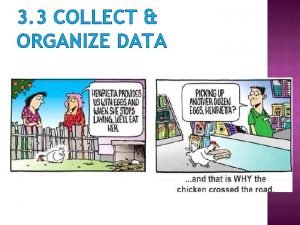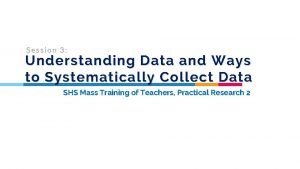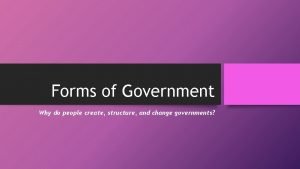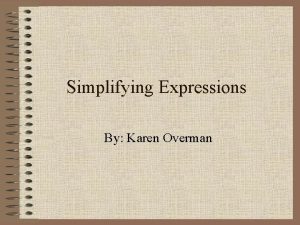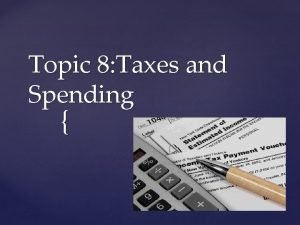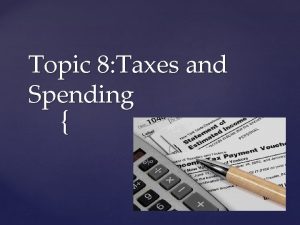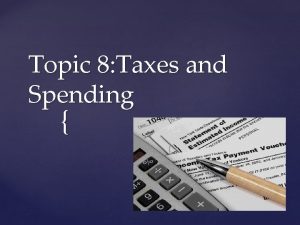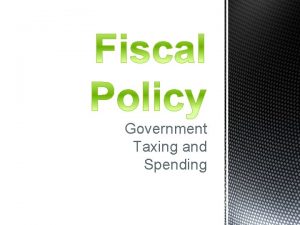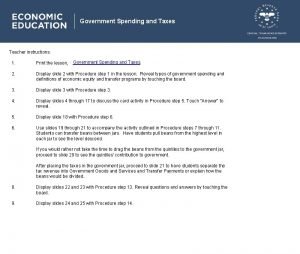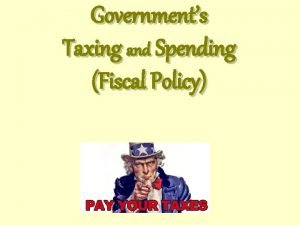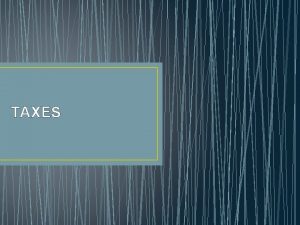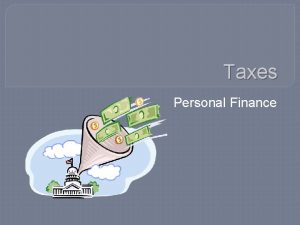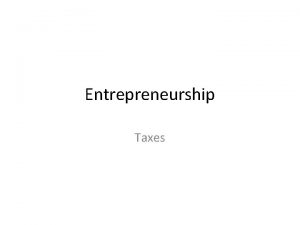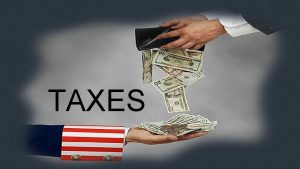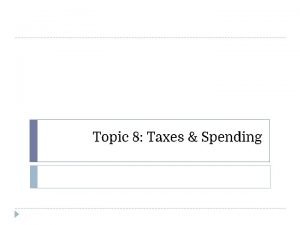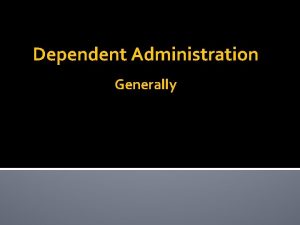Topic 8 Taxes and Spending Governments collect taxes



















- Slides: 19

Topic 8: Taxes and Spending {

Governments collect taxes to pay for programs, but taxes can have powerful effects on the general economy The federal government taxes income, the manufacture or sale of some goods, imports, and other sources of wealth The federal government spends tax money on mandatory outlays, including entitlements such as Social Security and on discretionary spending State taxes provide money for education, public safety, transportation, and other public goods Before We Get Into the Chapter…

Fairness is the goal of any tax system Some people argue that all people should be taxed the same Other people believe it should be based on what people earn Section 1: Understanding Taxes

When you receive a paycheck, there will be taxes that get taken out, but what are they for? State Income Tax Federal Income Tax FICA (Federal Insurance Contribution Act) = Social Security and Medicare Social Security- funds Old-Age, Survivors, and Disables Medicare- Health insurance for people who are older than 65 Income Taxes

We authorize the federal government, through the Constitution and Congress, to raise money in the form of taxes (under Article 1 Section 8) Taxation is the primary way that the government collects money The income received by a government from taxes and other nontax sources is called revenue We authorize the government to spend over $3. 5 trillion a year Taxes and the Government

The purpose of a tax must be “to pay the debts and provide for the common defense and general welfare of the United States” Tax cannot be for individual interests Federal taxes must be the same in every state Congress cannot tax religious services 24 th Amendment: “poll taxes” have been eliminated Constitution prohibits taxing exports Taxes must be paid by every single person Limits of Taxation

There are three types of structures: Progressive, Proportional, and Regressive Progressive taxes- tax for which the percentage of income paid in taxes increases as income increases People with higher incomes pay a higher percentage of their income in taxes People with very small incomes might pay no tax at all Proportional tax- tax for which the percentage of income paid in taxes remained the same at all income levels Regressive tax- tax for which the percentage of income paid in taxes decreases as income increases Sales taxes is an example Tax Structures


1. Simplicity- tax laws should be simple and easily understood 2. Efficiency- government administrators should be able to assess and collect taxes without spending too much time or money 3. Certainty- should be clear when a tax is due, how much is due and how the tax should be paid 3 Key Characteristics of a Tax


Government main source of revenues is the federal tax on individuals taxable income Income tax is a progressive tax- tax rate rises when the amount of taxable income The amount of federal income tax a person owes is determined on an annual basis Our system is “pay-as-you-earn” Helps support economic growth Employers are responsible for tax withholdings Tax withholdings- taking payments out of your pay before you received it Same for the whole year Section 2: Federal Taxes

Tax Return- form used to file income taxes Taxable income- a person’s gross (total) income minus exemptions and deductions Declare income and figure out how much is taxable Gross income includes earned income- salaries, wages, tips, and commissions Personal exemptions- set amounts that you subtract from your gross income for yourself, your spouse, and any dependents Tax deductions- mortgages interest, large medical expenses, and state and local tax payments Tax Return and Tax Deductions

Tax Credit- an amount you can subtract from the total amount of your income tax Completing a tax return allows you to determine whether the amount of income taxes you have already paid is higher or lower than the actual amount owed Other features of Tax

Mandatory spending- money that Congress is mandated by existing law to spend on certain programs or to use for interest payments on the national debt Discretionary spending- spending about which law makers are free to make choices Entitlements- social welfare programs that people are “entitled to” and benefit from if they meet certain eligibility requirements Section 3: Federal Spending

Fiscal policy: the use of government spending and revenue collection to influence the economy Used to expand /slow down economic growth, to achieve full employment, and maintain price stability. Government makes key fiscal policy decisions each year when it creates the federal budget. Federal Budget & Fiscal Policy

Executive Branch draws up budget with help of Office of Management & Budget. Congress debates, makes changes and returns to President for signature/veto. Role of committees: House Budget, Senate Budget, House Ways & Means, Senate Finance Fiscal year: a 12 month period used for budget purposes (Oct 1 through Sept 30). Figure 9. 2 Federal Budget Basics

Remember: the government uses fiscal policy to promote full employment and maintain stable prices. Two ways: Expansionary or Contractionary Fiscal Policy How does Fiscal Policy Impact the Economy?

Govts use expansionary fiscal policy to raise the level of output in the economy and encourage growth. This either prevents a recession or tries to move the economy out of a recession. Involves increasing govt spending, cutting taxe, or both. The goals is to increase demand, prices, and output. Expansionary Fiscal Policy

Contractionary Fiscal policy tries to decrease demand reduce the growth of economic output. Govt tries to slow down the economy to fight inflation, a rapid increase in prices. Govt can decrease spending, raise taxes, or both. Figure 9. 5 Contractionary Fiscal Policy
 State and local taxes and spending
State and local taxes and spending Chapter 14: taxes and government spending section 1
Chapter 14: taxes and government spending section 1 Chapter 14 taxes and government spending
Chapter 14 taxes and government spending Chapter 14 taxes and government spending
Chapter 14 taxes and government spending Third person example
Third person example Tapic about internet
Tapic about internet Syndicated sources
Syndicated sources Collect and organize data
Collect and organize data Understanding data and ways to systematically collect data
Understanding data and ways to systematically collect data Mari carlos and amanda collect stamps
Mari carlos and amanda collect stamps Why do people create, structure, and change government?
Why do people create, structure, and change government? How do the governments of kenya and nigeria compare?
How do the governments of kenya and nigeria compare? Is an anarchy limited or unlimited
Is an anarchy limited or unlimited John and marcia monthly spending plan 1 answer key
John and marcia monthly spending plan 1 answer key Why is evaluating and adjusting a spending plan important
Why is evaluating and adjusting a spending plan important Qualitative and quantitative research
Qualitative and quantitative research Meraki custom splash page
Meraki custom splash page How to collect like terms
How to collect like terms Show collect from air
Show collect from air Algebraic expression in simplest form
Algebraic expression in simplest form
